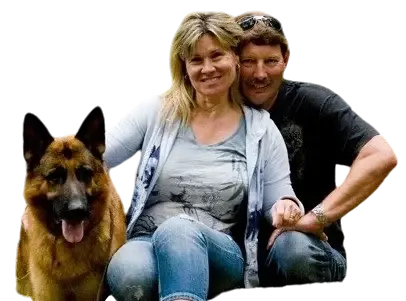
Schutzhund was developed in Germany in the early 1900s as a breed suitability test for the German Shepherd Dog. It was designed to test the breed’s natural instincts and weed out the dogs that were either unstable or untrainable. This helped ensure that breeding stock would pass on the most desirable traits to working dogs, such as police, military, and search and rescue dogs.
Over the past century, Schutzhund has remained a breed test but has also evolved into a sport that people from all walks of life can enjoy, from new dog owners to seasoned competitors. In many countries, Schutzhund titles are still considered prerequisites for breeding rights, and in some countries, Schutzhund is called “The Versatility Test for Working Dogs.” It offers an opportunity for dog owners to compete with each other for recognition of both the handler’s ability to train and the dog’s ability to perform as required. Persons of all ages and those with significant disabilities can participate and enjoy the sport. Often, it is a family hobby.
CALL Michael and Jeannette Today!
Your Loyal German Shepherd is Just a Call Away – Purebred and Ready for Your Family!

Misconceptions about Schutzhund
Contrary to the popular misconception that Schutzhund is “all about protection,” it is securely founded on obedience and control of a dog’s natural instincts and drives. Schutzhund dogs are safe, stable companions in the home and in public, good with children, under control, and at peace with their surroundings.
A Schutzhund trial begins with a temperament test for all entered dogs, where the handler must walk the dog through a crowd of strangers, and the judge observes the dog’s reaction to being approached closely on a loose leash. Dogs that show shyness or aggression are dismissed from the trial. This basic temperament test is repeated and must be passed before each trial. This helps ensure the dog is safe with strangers and in a crowded situation.
Schutzhund Trial Process
The three parts of a Schutzhund trial are tracking, obedience, and protection, and the dog must receive passing scores in all three phases to be awarded the title at a trial. Dogs that are out of control or show sound sensitivity are dismissed, as noted in their scorebook. Dogs that show aggression towards other dogs may be dismissed as well.
-
- Tracking in Schutzhund is sometimes referred to as “footstep tracking.” The dog must keep his nose on the ground the entire track and locate certain articles strategically placed on the track. The handler lays a Schutzhund 1 track, approximately 300 paces long, and aged approximately 20 minutes. The most advanced tracking titles are over 1800 paces, aged for 3 hours, and involve complex angles varying surfaces, and are laid by a stranger. Tracking tests the dog’s ability to concentrate on a single task for extended periods of time and independence in solving problems, as the handler must be 33 feet behind the dog. The working out of the track must be methodical and precise.
- The obedience phase requires many of the same exercises seen in other venues, such as heeling, sits, downs, and retrieves. In a Schutzhund routine, the paired handlers must report with their dogs off-leash. One dog performs a long down while the other does the routine. During the healing pattern, two shots are fired from a starter pistol to test the dog’s sound sensitivity. Later, the dog must be healed by a moving group of people. Dogs must retrieve large dumbbells on a flat, over a 1-meter jump and an A-Frame, and be under voice control with no hand signals. Handler help is penalized and may result in dismissal from the trial.
- The protection phase tests a dog’s ability to react appropriately and be under control at all times. The dog must find a hidden decoy and hold him in place with strong barking without a bite. The dog must return to the handler when called, prevent escapes and attacks by biting, yet be able to immediately release the bite and bark or sit quietly at the handler’s side. The dog and handler are required to heel next to the decoy and transport him to the judge, yet remain ready for defense against an attack. Dogs that are out of control are dismissed, and dogs that do not release the bite.
Recently, obtaining titles in single phases has become possible, and a new Rescue Dog suitability title has been obtained in some trials. Rules for Schutzhund titles are based on internationally accepted rules. Judges are often brought from Europe, and The United Schutzhund Clubs of America also maintains a judges program, licensing judges from within the organization.
United Schutzhund German Shepherds Clubs of America has developed a certification program for helpers, and nearly 400 have participated. This program involves attending seminars given by national teaching helpers and written and practical testing of the helper’s skills. A helper must demonstrate proper equipment, an understanding of the rules, and, most importantly, the ability to move and catch each dog safely. Helper classifications range from basic to national levels, and after each trial, a helper’s performance is critiqued by the presiding judge and noted in his Helper Book. This promotes fair testing of the dogs and vigilance concerning safety.
Conformation Shows
USCA also offers conformation shows, where the physical attributes of a dog are judged against the international standard. Dogs may be shown as puppies, allowing a chance for those with very young dogs to participate, and classes extend up to adult dogs with Schutzhund titles showing in the conformation ring. This promotes breeding for correct and sound physical structure. Schutzhund German Shepherd breeders are encouraged to adhere to strict standards involving a show rating, a Schutzhund title, an endurance test, and an acceptable hip rating on each bred dog.
Litter registration is prohibited in many countries unless the parents meet these criteria. This promotes consistent quality of the dogs being bred and allows potential buyers to review generations of hip ratings, conformation, and working titles. In America, the USA is a strong proponent of this system, which originated with the SV in Germany.
Importance of Schutzhund
Why is Schutzhund important to the future of the working breeds? A dog that performs well in Schutzhund should demonstrate a solid temperament with a foundation of intelligence and utility. He will show a high level of trainability and happiness for his tasks. These traits are highly sought after in police K9s and Search and Rescue dogs. Participating in Schutzhund German Shepherds keeps an important genetic pool alive for the dogs that serve and protect us. It also allows owners to enjoy an internationally recognized sport with their dogs, creating a stronger bond and a safe, well-mannered member of society.
Wustenberger-Land German shepherds are members of the United Schutzund Clubs of America.
If you want to purchase a titled German bloodline shepherd or German shepherd puppy, visit us.






